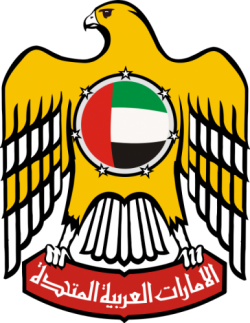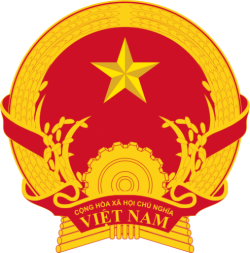Emblems Page #9
This page lists all the various symbols in the Emblems category.
An emblem is an abstract or representational pictorial image that represents a concept, like a moral truth, or an allegory, or a person, like a king or saint.
Although words emblem and symbol are often used interchangeably, an emblem is a pattern that is used to represent an idea or an individual. An emblem crystallizes in concrete, visual terms some abstraction: a deity, a tribe or nation, or a virtue or vice.
Symbols in this category:
Emblem of Kuwait
The Emblem of Kuwait (Arabic: شعار الكويت) was adopted in 1962 and it consists of the shield of the flag design in color superimposed on a golden falcon with wings displayed. The falcon supports a disk containing a boom sailing ship, a type of dhow, with the full name of the state written (in Arabic) at the top of the disk.
Emblem of Kyrgyzstan
The emblem of Kyrgyzstan was adopted following the dissolution of the Soviet Union on 2 June 1992. The emblem has a circular form which mostly bears the color blue. Light blue is known as the Kyrgyz color of courage and generosity (c.f. the flag of Kazakhstan and the emblem of Kazakhstan). To the left and right of the coat of arms, wheat and cotton are displayed. In the upper part, the name of the country appears in Kyrgyz "Кыргыз Республикасы" (Kyrgyz Respublikasy).
In the middle, the Tian Shan mountains are displayed, below which fields are shown. Behind the mountain panorama, one sees a rising sun. A hawk beating its wings stands under this panorama, which gives the impression that the panorama lies on the shoulders of the hawk.
Emblem of Laos
The national emblem of Laos shows the national shrine Pha That Luang. A dam is pictured which as a symbol of power generation at the reservoir Nam Ngun, an asphalt street is also pictured, as well as a stylized watered field. In the lower part is a section of a gear wheel. The inscription on the left reads "Peace, Independence, Democracy" (lao script: ສັນຕິພາບ ເອກະລາດ ປະຊາທິປະໄຕ) and on the right, "Unity and Prosperity" (lao script: ເອກະພາບ ວັດຖະນາຖາວອນ.)
Emblem of Maldives
The Maldivian National Emblem consists of a coconut palm, a crescent, and two criss-crossing National Flags with the traditional Title of the State.
Emblem of Mongolia
The state emblem of Mongolia (Mongolian: Монгол улсын төрийн сүлд, Mongol ulsyn t
Emblem of Sri Lanka
The national emblem of Sri Lanka is used by the State of Sri Lanka and the Sri Lankan government in connection with the administration and government of the country. The current emblem has been in use since 1972.
Emblem of Tajikistan
The State Emblem of Tajikistan is a modified version of the original coat of arms of the Tajik SSR that was in use until the dissolution of the Soviet Union in 1991. Like other post-Soviet republics whose symbols do not predate the October Revolution, the current emblem retains some components of the Soviet one. Prior to 1992, Tajikistan had a coat of arms similar to all other Soviet Republics.
Emblem of Thailand
The national emblem of Thailand (Thai: ตราแผ่นดินของไทย) is called the Phra Khrut Pha (RTGS transcription; พระครุฑพ่าห์; "Garuda as the vehicle" (of Vishnu)). The Garuda was officially adopted as the national emblem by King Vajiravudh (Rama VI) in 1911. However the mythical creature had been used as a symbol of royalty in Thailand for centuries. The Garuda is depicted on seals, which are used by the King of Thailand and the Government of Thailand to authenticate official documents and as its primary emblem.
Emblem of the United Arab Emirates
The emblem of the United Arab Emirates (Arabic: شعار الإمارات العربية المتحدة) was officially adopted in 1973. It is similar to the coats of arms and emblems of other Arab states. It consists of a golden falcon. The falcon had a red disk which shows an Arab sailboat in its interior. The disk is surrounded by a chain. The falcon holds with its talons a red parchment bearing the name of the federation in Kufic script.
Emblem of Turkmenistan
The State Emblem of Turkmenistan was created after Turkmenistan gained independence from the Soviet Union in 1991
Emblem of Uzbekistan
The state emblem of Uzbekistan was adopted on July 2, 1992. It is similar to the emblem of the previous Uzbek SSR. Like other post-Soviet republics whose symbols do not predate the October Revolution, the current emblem retains some components of the Soviet one. Prior to 1992, Uzbekistan had an emblem similar to all other Soviet Republics
Emblem of Vietnam
The emblem of Vietnam is circular, has red background and a yellow star in the middle which represent the Communist Party of Vietnam, the revolutionary history and bright future of Vietnam. The cog and crops represent the cooperation of agriculture and industrial labor.
Emblem of Yemen
The national emblem of Yemen depicts a golden eagle with a scroll between its claws. On the scroll is written the name of the country in Arabic: الجمهورية اليمنية or Al-Jumhuriyyah Al-Yamaniyah ("The Yemeni Republic"). The chest of the eagle contains a shield that depicts a coffee plant and the Marib Dam, that are below four blue and three wavy stripes. The flagstaffs on the right and left of the eagle hold the Flag of Yemen.
Equalists
Symbol of the Equalists, a revolutionary group featured in the television series “The Legend of Korra”.
Citation
Use the citation below to add this symbols category to your bibliography:
Style:MLAChicagoAPA
"Emblems Symbols." Symbols.com. STANDS4 LLC, 2024. Web. 21 Dec. 2024. <https://www.symbols.com/category/6/Emblems>.

















Have a discussion about the Emblems category with the community:
Report Comment
We're doing our best to make sure our content is useful, accurate and safe.
If by any chance you spot an inappropriate comment while navigating through our website please use this form to let us know, and we'll take care of it shortly.
Attachment
You need to be logged in to favorite.
Log In